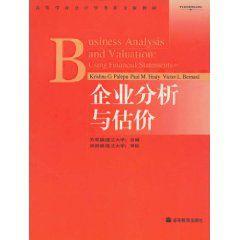內容簡介
《企業分析與估價》的框架結構獨具特色,不同於常見的“報表結構介紹一報表科目分析一比率分析”的體例安排,而是跳出會計數字的迷宮,從最原初的企業性質開始闡述財務報表與企業商業活動之間的關係,然後逐步講解戰略分析、會計政策分析和財務報表分析。全書包括三個部分:第一部分概要地介紹了“藉助財務報表進行商業分析和評估的框架”,第二部分具體展開描述了“商業分析和評估工具”,第三部分是前兩部分(框架和工具)在實務領域的套用,包括權益證券的價值評估、信用分析和破產危機預測、兼併收購的定價和融資等。 《企業分析與估價》理論與實務相結合的綜合訓練對身處以“3C(change、competition、customerization)”為特徵的信息經濟時代的學生很有益處,非常適合作為本科、會計學碩士和MBA的高級會計課程教材。
作者簡介
作者:(美國)帕利皮尤(palepu.K.G.)(美國)希利(HealyP.M.)(美國)伯納德(BernardV.L)編者:方軍雄KrishnaG.Palepu,美國哈佛商學院會計和控制學系首席教授,工商管理教授,其研究領域包括公司兼併收購的效率、公司財務政策、投資者溝通程式等。Palepu教授曾獲得1997年度wildman獎,美國會計學會1999年度會計人物傑出貢獻獎。PaulM.Healy,美國哈佛商學院工商管理教授,其研究領域包括公司披露政策及其對資本成本的影響、兼併收購的效率、盈餘管理和管理層激勵。Healy教授曾獲得美國會計學會1990年度和1999年度會計人物傑出貢獻獎,1997年度Wildman獎。victorL.Bernard,美國密西根大學佩頓會計研究中心會計學教授,其研究領域包括公司財務報告、財務報表分析、財務經濟學等。Bernarcl教授曾獲得美國會計學會1991年度、1993年度和1999年度會計人物傑出貢獻獎、1997年度Wildman獎。Bernard教授不幸於1995年辭世。改編及審校者簡介方軍雄,復旦大學管理學院會計學講師,師從於李若山教授,2002年獲得管理學博士學位,CPA,研究方向為會計與資本市場實證研究。洪劍峭,復旦大學管理學院會計學副教授,副系主任,師從於谷超豪院士,1994年獲得數學博士學位。研究領域包括會計與資本市場實證研究、解析會計研究。
目錄
Part 1 FRAMEWORK
A Framework for Business Analysis and Valuation Using
Financial Statements
The Role of Financial Reporting in Capital Markets
From Business Activities to Financial Statements
From Financial Statements to Business Analysis
Summary
Discussion Questions
Part 2 BUSINESS ANALYSIS AND VALUATION TOOLS Strategy Analysis
Industry Analysis
Applying Industry Analysis: The Personal Computer Industry
Competitive Strategy Analysis
Corporate Strategy Analysis
Summary
Discussion Questions
Overview of Accounting Analysis
The Institutional Framework for Financial Reporting
Factors Influencing Accounting Quality
Steps in Doing Accounting Analysis
Accounting Analysis Pitfalls
Value of Accounting Data and Accounting Analysis
Summary
Discussion Questions
Implementing Accounting Analysis
Recasting Financial Statements
Asset Distortions
Overstated Assets
Understated Assets
Liability Distortions
Equity Distortions
Summary
Discussion Questions
Appendix: Recasting Financial Statements Into Standardized Templates
Financial Analysis
Ratio Analysis
Cash Flow Analysis
Summary
Discussion Questions
Appendix: Part A: Nordstrom, Inc. Financial Statements
Part B: The TJX Companies, Inc. Financial Statements
Pr'ospective Analysis: Forecasting
Relation of Forecasting to Other Analyses
The Techniques of Forecasting
Making Forecasts
Sensitivity Analysis
Summary
Discussion Questions
Appendix: The Behavior of Components of ROE
Prospective Analysis: Valuation Theory and Concepts
Defining Value for Shareholders
The Discounted Abnormal Earnings Valuation Method
Valuation Using Price Multiples
Shortcut Forms of Earnings-Based Valuation
The Discounted Cash Flow Model
Comparing Valuation Methods
Summary
Discussion Questions
Appendix: Reconciling the Discounted Dividends and Discounted Abnormal Earnings Models
Prospective Analysis: Valuation Implementation
Detailed Forecasts of Performance
Computing a Discount Rate
Terminal Values
Computing Estimated Values
Summary
Discussion Questions
Part 3 BUSINESS ANALYSIS AND VALUATION APPLICATIONS
Equity Security Anlysis
Investor Objectives
Equity Security Analysis and Market Efficiency
Approaches to Fund Management and Securities Analysis
The Process of a Comprehensive Security Analysis
Performance of Security Analysts and Fund Managers
Summary
Discussion Questions
Credit Analysis and Distress Prediction
The Market for Credit
The Credit Analysis Process
Financial Statement Analysis and Public Debt
Prediction of Distress and Turnaround
Summary
Discussion Questions
Mergers and Acquisitions
Motivation for Merger or Acquisition
Acquisition Pricing
Acquisition Financing
Acquisition Outcome
Summary
Discussion Questions
Corporate Financing Policies
Factors That Determine Firms' Debt Policies
The Optimal Long-Term Mix of Debt and Equity
The Financing of New Projects
Factors That Determine Dividend Policies
Summary Discussion Questions
Communication and Governance
Governance Overview
Management Communication with Investors
Communication Through Financial Reporting
Other Forms of Communicating with Investors
Auditor Analysis
Audit Committee Reviews
Summary
Discussion Questions
Index

